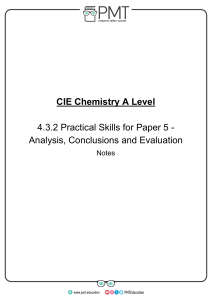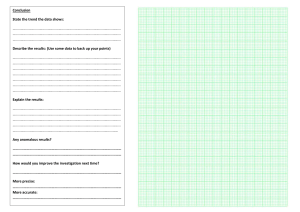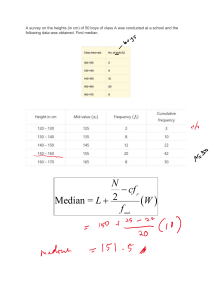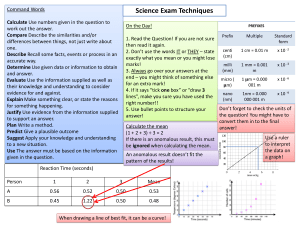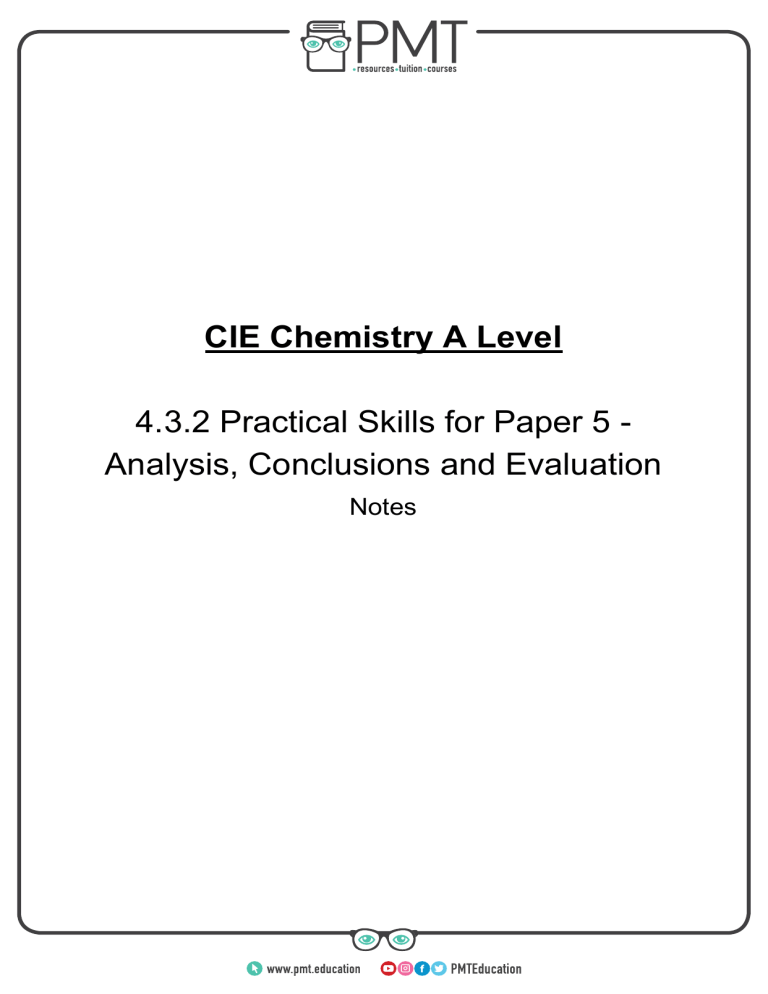
CIE Chemistry A Level 4.3.2 Practical Skills for Paper 5 Analysis, Conclusions and Evaluation Notes www.pmt.education Analysis, Conclusions and Evaluation Calculations When analysing quantitative data, calculations can be carried out to help summarise and simplify the data. Anomalous data (data that falls outside the trend) should not be included in calculations. Calculations should be referenced and their significance explained in the conclusion. Mean If an experiment is repeated, it is useful to calculate the mean to find the average of the values collected. Anomalous data should not be included in this calculation. The mean makes results more reliable by reducing the effect of random errors. To calculate the mean, add all the values and divide the total by the number of values. Calculated values should be given to the same number of significant figures as (or one more than) the least accurate quantity. Example one: An experiment was carried out four times to investigate the maximum temperature reached during a neutralisation reaction. The values obtained were 24.5, 23.5, 24.0 and 25.0. What is the mean maximum temperature reached? (24.5 + 23.5 + 24.0 + 25.0)/4 = 24.25 = 24.3 (to 3.s.f.) During a titration, it is only two concordant results (values within 0.1 cm3) that should be included in the mean calculation. Example two: The data for a titration is shown in the table below. Calculate the mean titre. Titre Volume of acid added (cm3) Rough titre 32.50 1 31.65 2 31.35 3 31.40 The two concordant results are 31.35 and 31.40 so these are the values used in the mean. The rough titre is never used as it is not accurate enough. = (31.35 + 31.40)/2 = 31.375 = 31.38 (to 2 decimal places) www.pmt.education Mode The mode is the most common value in the data. It is possible for there to be more than one mode in a set of data. Example: Find the mode for the following masses obtained from a reaction: 3.0, 4.5, 22.5, 2.5, 3.0, 4.0, 3.0, 4.5, 7.5. First put the values in ascending order. This makes the mode easy to spot: 2.5, 3.0, 3.0, 3.0, 4.0, 4.5, 4.5, 7.5, 22.5. Mode = 3.0. Median The median is the middle value in the data. To find the median, put the data in ascending number order then find the middle value. To find the position of the median in the data, usie the following calculation: (number of values +1)/2. Example: Find the median for the following masses obtained from a reaction: 3.0, 4.5, 22.5, 2.5, 3.0, 4.0, 3.0, 4.5, 7.5. First put the values in ascending order. This makes the median easy to find: 2.5, 3.0, 3.0, 3.0, 4.0, 4.5, 4.5, 7.5, 22.5. The median is the 5th value since (9+1)/2 =5. Median = 4.0. Percentage gain/ loss Percentage gain/ loss can be calculated for a range of different reasons during a reaction. It could be used to analyse things like the change in temperature or the change in pressure of a reaction but it is most commonly used to look at the change in mass in a reaction. Percentage change = (change/original) x 100 Example: 2.39 g of Magnesium is burned in oxygen to form 3.77 g of magnesium oxide. What is the percentage change of mass? = [(3.77-2.39)/2.39] x 100 = 66.0 % Presenting data Data tables Data tables are the most common way of presenting qualitative data as they clearly set out any observations and allow easy comparison. This is useful for identifying trends and drawing conclusions. In a data table, the independent variable is always in the first column and the dependent variable is in the next column. Units must be placed in the column headings of the table. www.pmt.education Scatter graphs Scatter diagrams are a very good way of presenting quantitative data as they allow for trends to be easily identified. They are not suitable for qualitative data. When drawing a scatter diagram, the independent variable goes on the x axis and the dependent variable goes on the y axis. A line of best fit should be drawn if possible, either straight or curved to suit the trend. If the line of best fit is a curve, it must be continuous and drawn freehand. Anomalous data must not be included in the line of best fit and instead should be identified with a circle. Anomalous results Anomalous results are values in the data collected which do not fit with the overall trend. Once data is confirmed to be anomalous, it should be discarded and the measurement must be taken again. If there is a value which is suspected to be anomalous, the measurement must be taken at least two more times to show that the new values lie near to one another and fit the trend. Only then can the anomalous piece of data can be concluded to be invalid. Anomalous data is easier to spot in quantitative data compared to qualitative data. This is partly because anomalies are very easy to spot on a scatter diagram as they lie outside of the line of best fit. When the line/curve of best fit is drawn, the anomalies must not be included and the data point should be circled to identify it as an anomaly. Making conclusions A conclusion is written at the end of an experiment to summarise the data and refer it back to the original hypothesis and prediction. Within the conclusion, the hypothesis should be reasserted and the conclusion must state whether the data supports it or not. The hypothesis can never be proven to be true, even if it is supported very strongly by the data. Calculations and values in the data must be referenced within the conclusion and their significance must be stated. Scientific knowledge must be used to explain the shape/trends of graphs and data. The results should also be evaluated by analysing how reliable the experiment was and suggesting relevant improvements. Evaluation The evaluation of the experiment is carried out at the end of the conclusion. The evaluation looks at how reliable the experiment was and suggests improvements to the techniques, apparatus or conditions used. How a proposed method could be improved Examples: ● Carrying out repeats to identify anomalies and calculate a mean. ● When observing a colour change in solution, does the method suggest placing a white tile underneath the reaction mixture to better observe the colour change? How the apparatus used could be improved Using apparatus with a higher resolution improves the precision of your readings. Examples: ● Using a pH probe instead of universal indicator. www.pmt.education ● Using a 25 cm3 measuring cylinder instead of a 50 cm3 flask to measure out 20 cm3. Identifying any steps that could cause error As well as identifying areas that could cause error you may also have to suggest how this error could be minimised. Examples: ● An experiment used to investigate the water potential of potatoes requires wet potatoes to be dried, in this example, drying should be done by the same person for the same length of time with each potato piece. ● An experiment which investigates rates of reaction uses the reaction between hydrochloric acid and sodium thiosulfate which produces a white precipitate, causing the solution to turn cloudy. A white cross is placed under the beaker and the time taken for the black cross to disappear is measured. The exact point when the cross disappears is subjective and the time would vary from person to person, so the same one person should say when the cross disappears each time. If you were to repeat an experiment, what changes you would make and why This can include changes to the method, apparatus or the range and intervals of the independent variable. Examples: ● If a trend was difficult to see then more values of the independent variable should be tested, such as instead of taking measurements at pH 6, pH 7, pH 8 and pH 9, next time you would test every 0.5 pH units from 5.5 to 9.5. ○ Test over a larger range and at smaller intervals Explaining why certain techniques/apparatus are used over others Examples: ● A good technique for measuring mass is the ‘weighing by difference’ method and is more accurate that taking a single mass measurement. The method - first weigh the container with the solid in it, then add the solid to the reaction and reweigh the container, the difference between these two values would be the mass of solid added. ● The resolution and precision of the apparatus should be considered ○ High resolution isn’t always best though - it would be better to measure 100 cm3 of a liquid using a 100 cm3 beaker instead of a 10 cm3 beaker as you would have to measure the liquid 10 times to reach 100 cm3 using the 10cm3 beaker Identifying variables that need to be controlled and how you would control them ● Control variables are needed in order to carry out a ‘fair test’. If these variables are not kept constant, the data will be invalid. ○ This enables the effects of changing the independent variable alone to be observed and recorded. ● A fair test is one that controls all of the variables in an experiment except one - the one that you change. This is the independent variable. Changing the independent variable will change the dependent variable (the variable that is being measured). ● Examples: www.pmt.education ○ ○ ○ Controlling temperature - place the required flask/beaker etc. in which the experiment is taking place in into a water bath. The temperature of the water changes much more slowly and is much more constant than the air temperature. Using the same volumes / concentrations / masses of chemicals used besides the independent variable in repeats. If the rate of reaction of two solutions is being measured at different temperatures, the concentration and volumes of the solutions must be kept exactly the same. Controlling pH - a pH buffer can be used to limit the changes in pH during a reaction Identifying functional groups As part of Paper 5, you are also expected to be able to be able to use qualitative tests to identify functional groups within an organic compound. Test for: Reagent(s) Positive Result Alkene (C=C) Add orange bromine water. Orange solution decolourises. Alcohol (-OH) Add ethanoyl chloride. The fumes will turn blue litmus paper red. Primary alcohol Add acidified potassium dichromate followed by Tollens reagent. Solution will turn from orange to green. Silver mirror formed after the addition of Tollen’s reagent. Secondary alcohol Add acidified potassium dichromate followed by Tollens reagent. Solution will turn from orange to green. No reaction with Tollen’s reagent. Tertiary alcohol Add acidified potassium dichromate. Solution will remain orange. Distinguish between aldehyde and ketone ● ● Add Tollen’s reagent Add Fehling’s solution ● ● Silver mirror formed for aldehyde, no reaction for ketone. Fehlings goes from blue to brick red for aldehyde, no reaction for ketone. Halogenoalkane Warm with ethanolic silver nitrate. Add ammonia solution. Chloroalkane - white precipitate soluble in dilute ammonia. Bromoalkane - cream precipitate soluble in concentrated ammonia. Iodoalkane - yellow precipitate insoluble in ammonia. Carboxylic acid Add sodium hydrogen carbonate solution. Fizzing. The gas produced gives a white precipitate with limewater. www.pmt.education
